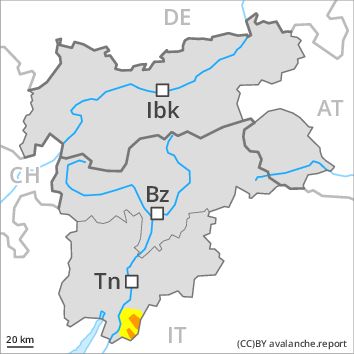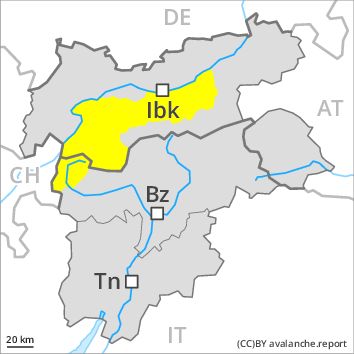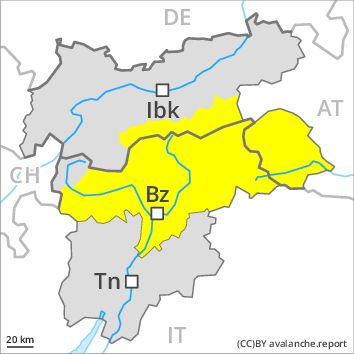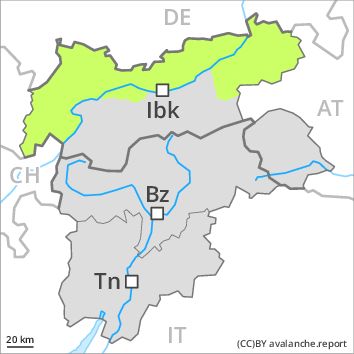Regions
Vallarsa

Danger level
Danger Level 3 - Considerable above 1500m
Danger Level 2 - Moderate above 1500m
Avalanche Problem
Wind-drifted snow above the treeline, N-NE-E-W-NW
Gliding snow above the treeline, E-SE-S-SW-W

More small and, in isolated cases, medium-sized moist loose snow avalanches are possible. The danger of moist avalanches will increase a little during the day.
On very steep grassy slopes more small and, in isolated cases, medium-sized gliding avalanches are possible. Elsewhere, avalanches can as before be released, in particular by large loads, in particular on wind-loaded slopes. The prevalence of avalanche prone locations and likelihood of triggering will increase with altitude.
Snowpack
dp 2: gliding snow
The snowpack remains moist at low and intermediate altitudes. Over a wide area fresh snow and wind slabs are lying on soft layers, especially above the tree line. Moist avalanches can in isolated cases be triggered in deep layers and reach medium size.
Tendency
The danger of moist avalanches will increase a little during the day.
Regions
Latemar, Southern Adamello, Primiero - Pale di S. Martino, Adamello - Presanella, Northern Brenta - Peller, Southern Brenta, Fassa Valley, Sole, Pejo and Rabbi, Southern Lagorai, Northern Lagorai, Maddalene, Paganella, Pine' - Mocheni Valley

Danger level
Danger Level 3 - Considerable above the treeline
Danger Level 2 - Moderate above the treeline
Avalanche Problem
Gliding snow above 2600m, N-NE-E-SE-S-SW-W-NW
Wind-drifted snow above 2200m, N-NE-E-W-NW

Wind slabs above approximately 2200 m. Gliding snow requires caution.
Wind slabs are extensive and can in some cases be released easily especially at their margins. Caution is to be exercised in particular adjacent to ridgelines and on steep northeast, north and northwest facing slopes. On steep grassy slopes more gliding avalanches are possible, even quite large ones. Caution is to be exercised in areas with glide cracks. The prevalence of avalanche prone locations and likelihood of triggering will increase with altitude. Snow sport activities outside marked and open pistes call for experience in the assessment of avalanche danger.
Snowpack
dp 2: gliding snow
dp 6: cold, loose snow and wind
The snowpack will be moist at low and intermediate altitudes. In some places wind slabs are lying on soft layers, in particular on shady slopes as well as adjacent to ridgelines in high Alpine regions.
Tendency
The danger of gliding avalanches and snow slides will decrease gradually.
Regions
Western Tuxer Alps, Eastern Tuxer Alps, Glockturm Range, Weißkugel Range, Val Müstair Alps, Gurgler Range, Langtaufers, Northern Oetz and Stubai Alps

Danger level
Danger Level 2 - Moderate
Avalanche Problem
Wind-drifted snow above 2400m, N-NE-NW
Gliding snow above 2600m, E-SE-S-SW-W

Fresh wind slabs require caution, in particular adjacent to ridgelines above approximately 2400 m. Caution is to be exercised in areas with glide cracks.
As a consequence of a sometimes strong southwesterly wind, sometimes avalanche prone wind slabs will form in particular in the regions exposed to the foehn wind. They can be released by a single winter sport participant in some cases especially on very steep shady slopes above approximately 2400 m. They are mostly small. The more recent wind slabs are clearly recognisable to the trained eye. Caution is to be exercised in particular adjacent to ridgelines. Old wind slabs are now only very rarely prone to triggering in high Alpine regions.
On steep grassy slopes more gliding avalanches are possible, especially in the regions exposed to heavier precipitation. Caution is to be exercised in areas with glide cracks. The danger of gliding avalanches will increase a little during the day.
Snowpack
dp 2: gliding snow
dp 6: cold, loose snow and wind
The snowpack will be moist at low and intermediate altitudes. The fresh wind slabs are lying on soft layers in particular on shady slopes above approximately 2400 m. The somewhat older wind slabs have bonded well with the old snowpack in all aspects. Faceted weak layers exist deep in the old snowpack above approximately 3000 m.
Tendency
The snow sport conditions outside marked and open pistes are generally favourable.
Regions
Sexten Dolomites, Schnals Ridge, Southern Stubai Alps, Southern Zillertal Alps and High Tauern, Saldurn-Mastaun Ridge, Texel Mountains, Sarntal Alps, Western Pfunderer Mountains, Eastern Pfunderer Mountains, Durreck Range, Western Rieserferner Mountains, Western Deferegger Alps, Central Stubai Alps, Ortler Range, Northern Zillertal Alps, Ulten Valley, Venediger Range, Eastern Nonsberger Alps, Eastern Rieserferner Mountains, Northern Dolomites of Fiemme, Glockner Range, Gröden Dolomites, Eastern Deferegger Alps, Prags Dolomites, Schober Mountains, Lienzer Dolomites

Danger level
Danger Level 2 - Moderate
Avalanche Problem
Gliding snow above 2600m, E-SE-S-SW-W
Wind-drifted snow above 2400m, N-NE-NW

Caution is to be exercised in areas with glide cracks. Fresh wind slabs require caution, in particular adjacent to ridgelines above approximately 2400 m.
On steep grassy slopes the danger of gliding avalanches will decrease a little to level 2 (moderate). More gliding avalanches are possible, even quite large ones, especially on sunny slopes below approximately 2600 m. Areas with glide cracks are to be avoided as far as possible. As a consequence of warming there will be only a slight increase in the danger of gliding avalanches.
As a consequence of a sometimes strong southwesterly wind, sometimes avalanche prone wind slabs will form in particular in the regions exposed to the foehn wind. They can be released by a single winter sport participant in some cases especially on very steep shady slopes above approximately 2400 m. They are mostly small. The fresh wind slabs are clearly recognisable to the trained eye. Caution is to be exercised in particular adjacent to ridgelines.
Old wind slabs are now only very rarely prone to triggering in high Alpine regions.
The snow sport conditions outside marked and open pistes are generally favourable.
Snowpack
dp 2: gliding snow
dp 6: cold, loose snow and wind
The snowpack will be moist at low and intermediate altitudes. The fresh wind slabs are lying on soft layers in particular on shady slopes above approximately 2400 m. The somewhat older wind slabs have bonded well with the old snowpack in all aspects. Faceted weak layers exist deep in the old snowpack above approximately 3000 m.
Tendency
Gliding snow represents the main danger.
Regions
Prealps, Cembra Valley, Bondone and Stivo, Western Nonsberg Alps, Folgaria - Laverone, Ledro Valley, Marzola - Valsugana

Danger level
Danger Level 2 - Moderate
Avalanche Problem
Wind-drifted snow above the treeline, N-NE-E-W-NW
Gliding snow above the treeline, E-SE-S-SW-W

Individual mostly small moist loose snow avalanches are possible. The danger of moist avalanches will increase a little during the day.
On very steep grassy slopes individual mostly small gliding avalanches are possible. Elsewhere, avalanches can in some places be released, mostly by large loads, but they will be small in most cases, in particular on wind-loaded slopes. The prevalence of avalanche prone locations and likelihood of triggering will increase with altitude.
Snowpack
dp 2: gliding snow
The snowpack remains moist at low and intermediate altitudes. Over a wide area fresh snow and wind slabs are lying on soft layers, especially above the tree line. Dry and moist avalanches can in isolated cases penetrate deep layers and reach medium size.
Tendency
The danger of moist and wet avalanches will increase a little during the day.
Regions
Western Verwall Mountains, Eastern Verwall Mountains, Allgäu Alps, Silvretta, Samnaun Mountains, Eastern Lechtal Alps - Ammergau Alps, Mieming Mountains, Karwendel Mountains, Brandenberg Alps, Western Kitzbühel Alps, Wilder Kaiser Mountains - Waidring Alps, Eastern Kitzbühel Alps, Western Lechtal Alps, Central Lechtal Alps, Grieskogel Mountains

Danger level
Danger Level 1 - Low
Avalanche Problem
Wind-drifted snow above 2400m, N-NE-NW
Gliding snow above 2600m, E-SE-S-SW-W

Fresh wind slabs in the high Alpine regions. Slides can occur on steep grassy slopes.
Individual avalanche prone locations for dry avalanches are to be found in particular on very steep shady slopes above approximately 2400 m, and adjacent to ridgelines. Such avalanche prone locations are very rare and are easy to recognise. Individual avalanche prone locations for gliding avalanches are to be found in particular on steep grassy slopes below approximately 2600 m, especially in the regions exposed to heavier precipitation. The danger of gliding avalanches will increase a little during the day.
Snowpack
dp 6: cold, loose snow and wind
dp 2: gliding snow
As a consequence of a sometimes strong southwesterly wind, rather small wind slabs will form at elevated altitudes. In some places wind slabs are lying on the soft surface of an old snowpack, in particular above approximately 2400 m on shady slopes. At low and intermediate altitudes hardly any snow is lying.
Tendency
Low, level 1.






